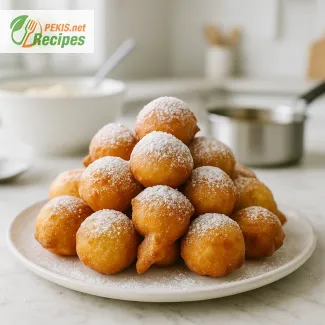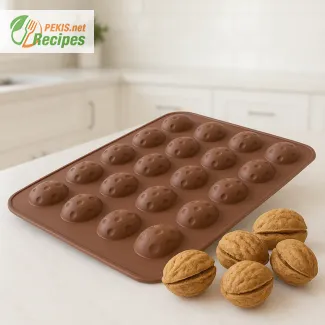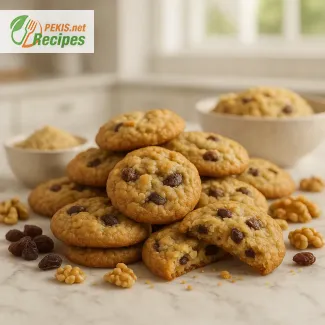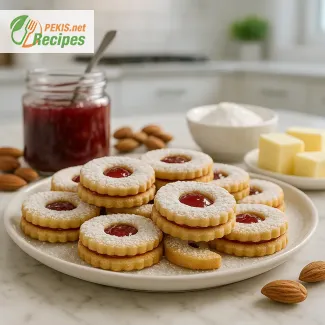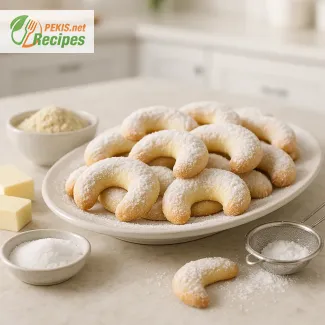Gluten-free St. Nicholas’ gingerbread makes 20 pieces in just 25 minutes of preparation and 15 minutes of baking for a total of 40 minutes. Soft inside with a golden, spiced crust, it blends honey, rice flour, almond flour, and cinnamon for a festive aroma. The dough keeps well when stored in an airtight container for up to two weeks, and its flavor deepens over time. Perfect for holiday gifting or cozy evenings, these cookies stay tender, fragrant, and beautifully traditional — without a trace of gluten.
Creating gluten-free versions of traditional holiday treats has always been a favorite challenge — especially when the goal is to keep that authentic aroma of honey and spices alive. Years of working with different flours taught how texture and balance make all the difference; the right mix of rice and almond flour gives this gingerbread its soft, tender bite without losing the classic feel. The smell of cinnamon and cloves filling the kitchen during baking is the reward on its own, reminding how simple ingredients can create something truly festive.
PEKIS – professional chef and recipe developer with over 25 years of experience in cooking and baking, specialized in European and international cuisine.

Gluten-free St. Nicholas’ Gingerbread – A Festive Treat with Traditional Spices
A soft, spiced, and aromatic December classic made without gluten yet full of warmth and nostalgia
When the air fills with the scent of warm honey, cinnamon, and cloves, it can only mean one thing – the arrival of St. Nicholas’ Day. This time-honored celebration brings with it the comforting aroma of gingerbread baking in the oven, evoking memories of snowy evenings, glowing candles, and handmade gifts. Gluten-free St. Nicholas’ gingerbread captures the same heartwarming essence as the traditional version, only reimagined for those who want or need to avoid gluten. The dough remains fragrant, slightly chewy at the center, with that familiar golden-brown crust that crackles under your fingertips. Every bite feels like a sweet whisper of the past blended with today’s care for wholesome ingredients.
Unlike many modern cookies, this gingerbread variation stays true to its roots: honey gives natural sweetness and moisture, while cinnamon, cloves, nutmeg, and cardamom create a multi-layered aroma that deepens as the dough rests. Instead of wheat flour, a balanced mix of rice flour, almond flour, and potato starch builds a soft, tender structure that doesn’t crumble. A touch of butter or plant-based fat enriches the flavor, helping the spices bloom in the oven. The result is a gingerbread that feels indulgent yet gentle, rustic yet elegant — a perfect combination of tradition and modern dietary awareness.
The origins and tradition of St. Nicholas’ gingerbread
The story of St. Nicholas’ gingerbread stretches back to medieval Europe, particularly regions around Belgium, the Netherlands, and Central Europe, where it was known as Lebkuchen or Speculoos. Bakers would shape the dough into figurines of St. Nicholas, angels, or animals, pressing them into hand-carved wooden molds. These cookies were not just treats — they were symbols of generosity and kindness, gifted to children during the December celebrations. Over the centuries, each country added its own touch: honey instead of sugar, new spice blends from distant trade routes, or regional nuts and dried fruits. This gluten-free adaptation continues that evolution, proving that even ancient recipes can thrive in modern kitchens.
Why you’ll love this gluten-free gingerbread
- Authentic flavor – Deep, aromatic spices and honey recreate the original festive warmth.
- Soft texture – Moist and chewy inside, lightly crisped edges on the outside.
- Naturally festive – The perfect scent to fill your home during December baking.
- All-family friendly – Gluten-free and suitable for sharing at holiday gatherings.
- Customizable – Easily shaped into hearts, stars, or St. Nicholas figurines.
The secret behind perfect texture and flavor
Each ingredient plays its own role in achieving the perfect balance. Honey adds moisture and depth of flavor, giving the dough its signature elasticity. Ground nuts or almond flour provide richness, while starches such as tapioca or potato bind the ingredients and mimic the structure that gluten would otherwise provide. Eggs contribute lightness and help the gingerbread rise slightly, giving it a soft, cake-like consistency. A pinch of salt enhances the sweetness and accentuates the spice profile, ensuring every bite feels harmonious. To maintain tenderness, the dough benefits from resting overnight, allowing the spices to infuse and the texture to develop fully.
Storing and preparing in advance
Gluten-free gingerbread keeps beautifully when stored properly. Once baked and cooled, it can be placed in an airtight tin lined with parchment and stored at room temperature for up to two weeks. The flavor deepens over time, making it even more fragrant after a few days. For longer storage, freeze the baked cookies in a sealed container and let them thaw gently at room temperature before serving. You can also prepare the dough ahead of time, wrap it tightly, and refrigerate it for up to three days — the resting period enhances the spice blend and improves dough handling.
Creative variations and flavor twists
- Add a touch of orange zest or grated ginger for a citrusy note.
- Brush with a thin layer of honey glaze or decorate with royal icing for a festive look.
- Replace butter with coconut oil for a dairy-free option and a delicate exotic aroma.
- Mix in finely chopped nuts or dried cranberries for added texture and color.
- Shape into small gift cookies tied with ribbons for an authentic St. Nicholas tradition.
Festive pairings and serving ideas
These gluten-free gingerbread cookies pair beautifully with mulled wine, hot cocoa, or spiced tea. Serve them alongside almond milk or vanilla custard for a comforting dessert plate, or crush them into crumbs to use as a base for holiday cheesecakes. Their gently sweet and spicy taste complements seasonal fruits like oranges, apples, and pears, making them a versatile addition to any festive menu.
Cultural connection and sensory experience
Across Europe, gingerbread has always symbolized warmth, home, and generosity. Whether you call them Lebkuchen, Speculaas, or Medenjaki, these cookies embody the heart of winter celebration. The gluten-free St. Nicholas’ gingerbread carries this legacy forward, preserving the traditional spice blend while embracing inclusive baking. As the honey caramelizes in the oven, the kitchen fills with that unmistakable scent — sweet, spicy, and comforting — a timeless reminder that festive baking is not just about the taste, but the memories it creates.
- In a small saucepan, gently heat honey and butter over low heat until smooth and melted. Allow to cool slightly.
- In a large bowl, whisk eggs and brown sugar until light and fluffy. Slowly pour in the melted honey-butter mixture while stirring constantly.
- Add milk and lemon zest, mixing until well combined.
- In a separate bowl, combine rice flour, almond flour, potato starch, baking powder, salt, and all the spices (cinnamon, ginger, cloves, nutmeg).
- Gradually fold the dry mixture into the wet ingredients, mixing until a soft, slightly sticky dough forms.
- Wrap the dough in plastic wrap and let it rest in the refrigerator for at least 1 hour (this allows the flavors to develop and the dough to firm up).
- Preheat the oven to 180°C (356°F). Line a baking tray with parchment paper.
- Roll out the dough on a lightly floured surface to about 0.5 cm (0.2 inch) thickness. Cut out shapes with cookie cutters (stars, hearts, or St. Nicholas figures).
- Place the cookies on the prepared tray, leaving a little space between them.
- Bake for 12–15 minutes until golden brown and fragrant.
- Cool completely on a wire rack, then dust lightly with powdered sugar (for decoration) or decorate with icing if desired.
FAQ questionCan I make St. Nicholas’ gingerbread ahead of time?
Yes. This dough actually improves with rest because the spices, honey, and citrus have time to blend. You can prepare the dough, wrap it tightly, and refrigerate it for up to 3 days before rolling and baking. Baked cookies keep well in an airtight tin for about 2 weeks, and the flavor becomes even more festive after a day or two. For longer storage, freeze the baked cookies and thaw at room temperature.
FAQ questionHow do I keep gluten-free gingerbread from crumbling?
Gluten-free cookies can crumble if the flour mix is too dry or if there’s not enough fat or binding. In this recipe, honey, eggs, and butter work together to keep the structure soft. Using a mix of rice flour + almond flour + starch helps mimic the tenderness of wheat dough. Letting the dough rest and not overbaking (12–15 minutes is enough) are key to getting a chewy, not sandy texture.
FAQ questionCan I decorate these gingerbread cookies?
Absolutely. Once completely cooled, you can dust them with powdered sugar, drizzle with honey glaze, or pipe royal icing for a more traditional St. Nicholas look. Because the surface is slightly firm and the center is soft, the icing adheres well. If using icing, let it dry at room temperature before stacking or packing.
FAQ questionCan I make this recipe dairy-free as well as gluten-free?
Yes. Replace the butter with a good-quality plant-based margarine and use oat milk or almond milk instead of regular milk. The texture will remain soft because the structure doesn’t depend on dairy but on the honey, eggs, and flour mix. The flavor will be slightly different, so adding a bit of vanilla or orange zest is a good idea.
FAQ questionWhat makes this different from regular gingerbread cookies?
Two things: the gluten-free flour combination and the St. Nicholas tradition. Regular gingerbread often uses only wheat flour and sometimes molasses. This version uses honey, warm spices, and a gentle flour blend to stay close to Central European St. Nicholas cookies. The result is a lighter, more aromatic cookie that people with gluten intolerance can enjoy without missing out on the holiday feeling.
FAQ questionWhy is honey important in this recipe?
Honey doesn’t just sweeten — it helps with moisture, color, and aroma. It caramelizes slightly during baking, giving the gingerbread its golden tone and soft bite. It also pairs naturally with cinnamon, cloves, nutmeg, and ginger, which are typical for December baking. Using sugar alone would make the cookie drier and less festive in flavor.
The comforting scent of honey, cinnamon, and cloves defines the heart of the holiday season, and gluten-free St. Nicholas’ gingerbread captures that spirit perfectly. Every bite feels like a connection to centuries of European baking tradition, where warmth and generosity were expressed through simple, fragrant cookies. It’s a dessert that balances nostalgia and inclusivity, allowing everyone at the table to enjoy the magic of December.
This version preserves the authentic flavor and soft texture that make traditional gingerbread so loved, while proving that gluten-free baking can be every bit as satisfying. The gentle sweetness of honey, the depth of ginger and nutmeg, and the hint of citrus zest create a cookie that’s rich yet balanced. With each batch, the dough’s natural rest brings out even more complexity, turning a simple bake into an aromatic ritual of winter warmth.
Perfectly suited for holiday gatherings, gifting, or quiet evenings, these cookies bring an unmistakable sense of comfort. They pair effortlessly with tea, cocoa, or mulled wine and fill the home with that cozy festive aroma that lingers long after baking. Stored properly, their flavor deepens over time — proof that good things truly become better with patience.
Gluten-free St. Nicholas’ gingerbread reminds that festive baking is about more than ingredients; it’s about preserving tradition while embracing change. It unites texture, scent, and sentiment into a single joyful creation — a sweet reminder that the warmth of the holidays belongs to everyone.
Allergens present in the recipe:
- Eggs – used in the dough to bind and add moisture.
- Milk – present in butter and added milk.
- Nuts (almonds) – almond flour provides structure and flavor.
Substitution tips to remove allergens and gluten:
- Replace almond flour with sunflower seed flour for a nut-free version.
- Substitute butter and milk with plant-based margarine and almond or oat milk for a dairy-free version.
- This recipe is already gluten-free – no substitution needed for flour.
- Vitamin E – 2.3 mg – supports healthy skin and immune function.
- Calcium – 34 mg – contributes to strong bones and teeth.
- Magnesium – 22 mg – helps muscle and nerve function.
- Iron – 0.8 mg – aids in red blood cell formation.
- Potassium – 95 mg – supports normal muscle function.
- Cinnamaldehyde – 0.6 mg – from cinnamon, supports anti-inflammatory activity.
- Gingerol – 0.3 mg – from ginger, promotes digestion and boosts immunity.
- Flavonoids – 0.9 mg – from honey and almonds, help protect cells from oxidative stress.
- Vitamin E – 2.3 mg – acts as a natural antioxidant for cell protection.
